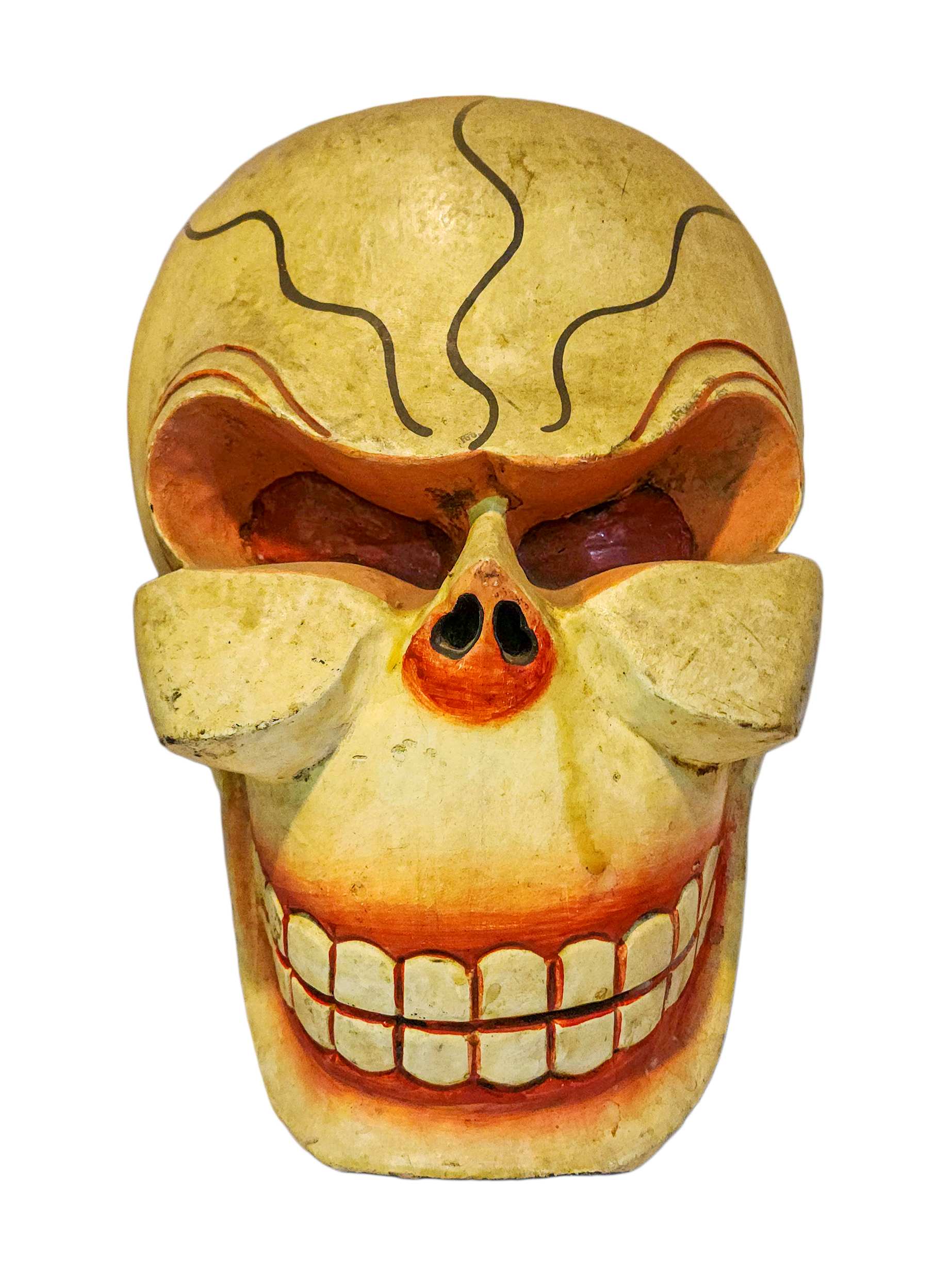Skull
A "Buddhist skull" typically refers to a symbolic representation or a physical object associated with Buddhist practice, rituals, or artistic symbolism. Here's a description and explanation of the concept.
In Buddhist iconography and symbolism, the skull (often depicted as a human skull) holds profound significance, representing various aspects of impermanence, wisdom, and transformation within Buddhist teachings.
Read More
Symbolism of Impermanence: The skull is a potent symbol of impermanence (anicca) and the transient nature of life. It serves as a reminder of mortality and the inevitability of death, encouraging practitioners to contemplate the impermanent nature of all phenomena.
Symbol of Wisdom (Kapala): In certain Buddhist traditions, particularly in Vajrayana (Tibetan Buddhism), the skull can be specifically referred to as a "kapala," which translates to "skull cup." A kapala is a ritual implement made from a real human skull used in certain tantric practices. It symbolizes the transformation of negative emotions into wisdom and the transcendence of ego-based attachments.
Use in Tantric Rituals: Within Vajrayana Buddhism, the kapala plays a ritualistic role in ceremonies known as Chod (or "cutting through ego"), where practitioners visualize offering their own body as a feast to spiritual beings. This practice symbolizes the practitioner's fearless engagement with impermanence and the ultimate reality of emptiness.
Artistic Symbolism: In Buddhist art, skulls can be depicted as adornments or decorative elements on wrathful deities or protectors, symbolizing their transcendence over death and ego. Skulls may also be featured in thangka paintings, sculptures, and ritual objects as a potent symbol of transformation and spiritual realization.
Cultural Context: The significance of the skull in Buddhist culture reflects broader themes of Buddhist philosophy, including the Four Noble Truths and the practice of mindfulness of death. Meditating on the image of a skull is a contemplative practice aimed at deepening insight into the nature of existence.
Ethical Considerations: It's important to note that in Buddhist contexts, the use of actual human remains (such as kapalas) in rituals is subject to ethical guidelines and cultural sensitivities. Many modern practitioners use symbolic representations of skulls or other ritual objects to engage with the teachings of impermanence and wisdom.
In summary, the Buddhist skull symbolizes profound spiritual themes related to impermanence, wisdom, and transformation within Buddhist philosophy and practice. Its symbolism invites practitioners to contemplate the nature of existence and the path towards awakening, emphasizing the impermanent and interconnected nature of all phenomena.
About Wooden Mask
this Skull mask is Nepali handmade mask and we are Introducing our exquisite collection of Nepali handmade hand-carved wooden Buddhist masks and wall hangings, meticulously crafted by skilled artisans. Each piece in this collection reflects the rich cultural heritage and spiritual significance of Nepal. These masks and wall hangings are not just decorative pieces but hold deep symbolic meaning, making them perfect for adding an authentic touch to your living spaces or meditation rooms.
Made from high-quality, ethically sourced wood, these masks and wall hangings are the epitome of craftsmanship. Each intricate detail is delicately carved by hand, showcasing the artistry and dedication of the artisans. Whether you're a collector, a spiritual seeker, or simply appreciate the beauty of traditional craftsmanship, these wooden Buddhist masks and wall hangings will captivate your senses and bring a sense of tranquility to your surroundings. Hang them on your walls or display them as a centerpiece, and let their timeless beauty and spiritual aura create a serene atmosphere in your home or office. Discover the magic of Nepali artistry with our hand-carved wooden Buddhist masks and wall hangings today.
Read More
About Color Finishing
The Skull is adorned with traditional colors, creating a captivating aesthetic through a combination of gold and various hues. This painting technique follows a time-honored process that aims to faithfully represent the Skull in accordance with traditional color descriptions. In the context of Buddhist statues, this approach holds great significance. Each statue has its own primary color, and it is crucial to depict the statue in its authentic shade.
This adherence to color accuracy is akin to the meticulous artistry seen in thangka paintings. To achieve this finishing, organic colors and genuine gold are used, while the expertise of a skilled thangka artist is sought, as painting on a metal surface requires a distinct set of skills to bring out the elegance and beauty of the statue.
By employing this traditional coloring method, the Skull is not only aesthetically pleasing but also maintains its cultural authenticity, paying homage to the rich traditions and practices associated with Buddhist art.
Read More
Brief Introduction
This wooden mask is made from the finest poplar wood, embodying both natural beauty and artistic craftsmanship. The light, creamy tones of the poplar wood lend an air of elegance to this unique mask. Its intricate details and smooth texture showcases the exceptional workability of poplar wood, allowing for precise carving and shaping. With its durability and timeless appeal, this poplar wood mask is a stunning addition to any space, adding a touch of cultural richness and artistic charm to your decor.
